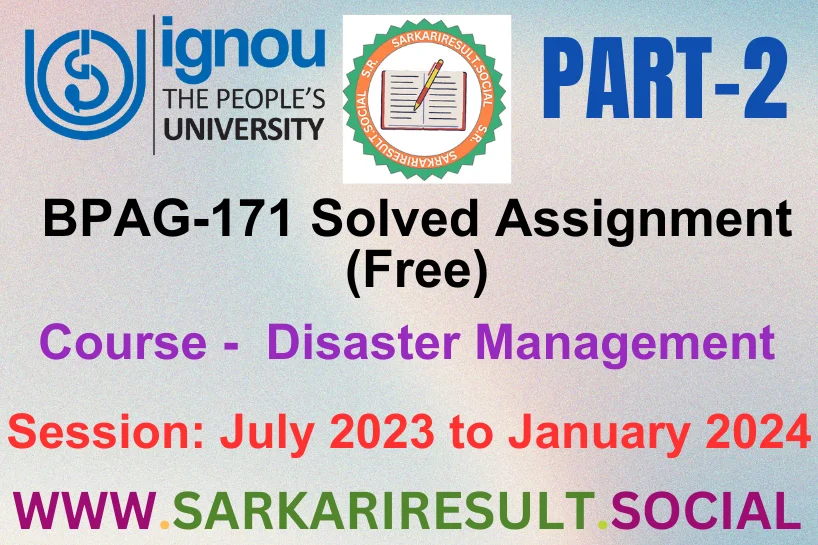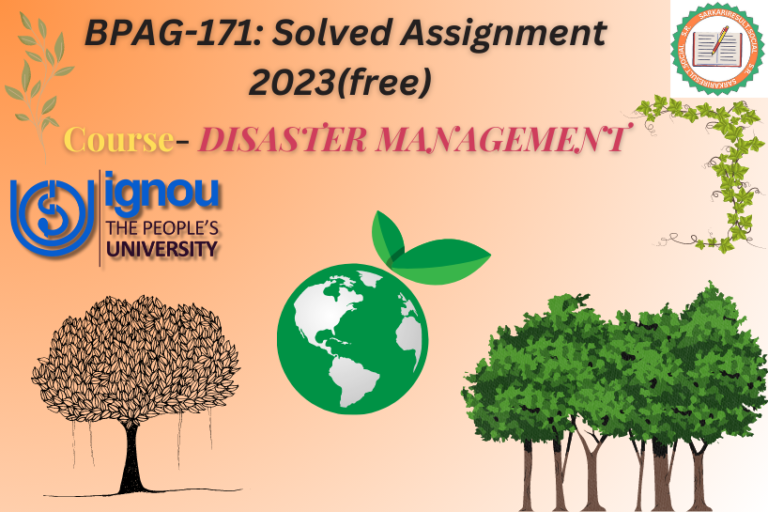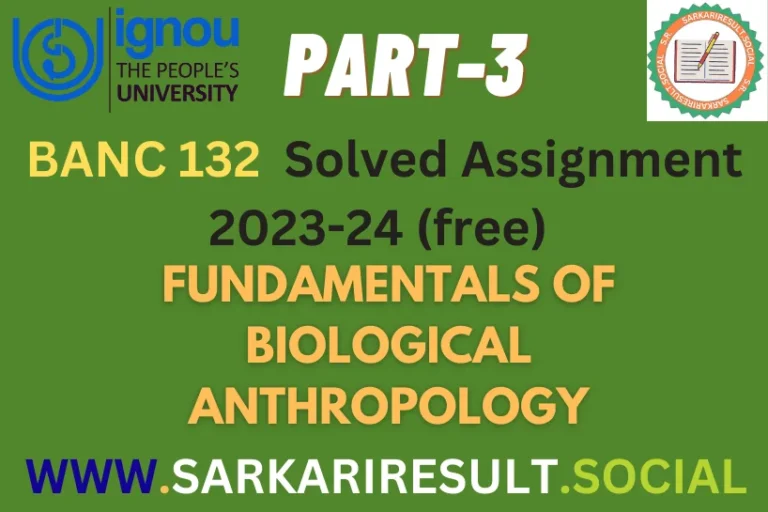BPAG 171 SOLVED IGNOU ASSIGNMENT FREE PART 2

Welcome to the BPAG 171 SOLVED IGNOU ASSIGNMENT FREE PART 2 TMA. Assignment B streamlines your approach with concise answers to three pivotal questions. In about 250 words each, explore factors contributing to vulnerability, understand disaster preparedness and its types, and highlight indigenous coping strategies during cyclones and droughts. Our short and focused responses provide a straightforward path for grasping these critical aspects of disaster management, ensuring a smooth and successful completion of your assignments. Our IGNOU Solved Assignments 2024 for this section serve as your creative guide.

Answer the following questions in about 250 words each.
Q.3 Briefly discuss the various factors that contribute to vulnerability.
Ans. Vulnerability to disasters is a complex interplay of various factors that amplify the impact of hazards on individuals, communities, and societies. Here are key elements contributing to vulnerability:
1. Geographical Location:
– Proximity to Hazards: Regions located near coastlines, fault lines, or in flood-prone areas are more vulnerable to specific hazards like hurricanes, earthquakes, and floods.
– Climate Sensitivity: Areas prone to extreme weather events, such as droughts or heatwaves, face heightened vulnerability.
2. Socioeconomic Status:
– Poverty: Low-income communities often lack resources for disaster preparedness, have limited access to healthcare, and reside in poorly constructed housing.
– Inequality: Disparities in wealth and resources contribute to differential impacts, as marginalized groups face greater challenges in coping with disasters.
3. Infrastructure and Urbanization:
– Poor Infrastructure: Weak infrastructure, inadequate building standards, and informal settlements increase susceptibility to damage during disasters.
– Rapid Urbanization: Unplanned urban growth leads to increased vulnerability due to insufficient infrastructure and high population density.
4. Environmental Degradation:
– Deforestation: Loss of natural barriers like forests increases susceptibility to landslides and flash floods.
– Land Use Changes: Alterations in land use patterns can amplify flood risks and disrupt ecosystems, impacting resilience.
5. Healthcare Systems:
– Health Access: Limited access to healthcare facilities and services reduces the capacity to respond effectively to health-related impacts of disasters.
– Pre-existing Health Conditions: Populations with high prevalence of diseases are more vulnerable, as disasters can exacerbate health issues.
6. Social and Cultural Factors:
– Social Cohesion: Communities with strong social networks often exhibit greater resilience, while fragmented societies face challenges in coordinated response.
– Cultural Practices: Traditional practices that may enhance or hinder preparedness and response efforts.
7. Education and Awareness:
– Educational Levels: Higher education levels contribute to better understanding and preparedness for disasters.
– Awareness Programs: Effective communication and awareness campaigns can mitigate vulnerability by promoting preparedness.
8. Governance and Institutional Capacity:
– Effective Governance: Countries with strong governance structures and institutions are better equipped to manage disasters.
– Corruption: Corruption weakens the effectiveness of disaster response and recovery efforts, exacerbating vulnerability.
9. Climate Change:
– Changing Climate Patterns: Altered weather patterns, rising sea levels, and increased frequency of extreme events contribute to heightened vulnerability.
– Global Impacts: Vulnerability is exacerbated by global factors, such as economic dependencies and geopolitical dynamics.
Understanding and addressing these multifaceted factors is crucial for comprehensive disaster risk reduction strategies. By identifying and mitigating vulnerability drivers, communities and societies can enhance resilience and reduce the impacts of future disasters.
Q.4 Write a note on disaster preparedness and its types.
Ans. Disaster preparedness is a proactive and systematic approach aimed at minimizing the impact of disasters by enhancing the resilience of communities and individuals. It involves a combination of planning, training, resource allocation, and public awareness to ensure an effective response when disasters occur.
1. Early Warning Systems:
– Timely Alerts: Preparedness includes the establishment of early warning systems that provide timely alerts about impending disasters, allowing people to evacuate or take protective measures.
2. Evacuation Planning:
– Safe Routes: Preparedness involves developing evacuation plans with clearly defined and well-marked routes to ensure the safe movement of people away from the disaster-affected areas.
3. Community Training and Drills:
– Simulation Exercises: Regular drills and training sessions are conducted to familiarize communities with emergency procedures, evacuation protocols, and first aid practices.
4. Emergency Supplies and Stockpiling:
– Essential Resources: Preparedness involves creating stockpiles of essential supplies such as food, water, medical kits, and blankets to meet the immediate needs of affected populations.
5. Infrastructure Resilience:
– Building Standards: Communities invest in resilient infrastructure and adhere to construction standards that mitigate the impact of disasters, reducing damage to buildings and critical facilities.
6. Communication Strategies:
– Public Awareness Campaigns: Preparedness includes public awareness campaigns that educate communities about potential risks, the importance of preparedness, and the actions to be taken during disasters.
7. Search and Rescue Operations:
– Trained Response Teams: Preparedness involves training specialized search and rescue teams equipped to respond quickly and efficiently to locate and assist individuals in distress.
8. Coordination and Partnerships:
– Interagency Collaboration: Preparedness emphasizes coordination between governmental agencies, non-governmental organizations, and community groups to ensure a cohesive and effective response.
9. Emergency Shelter Plans:
– Designated Safe Spaces: Communities establish plans for emergency shelters with clearly identified locations where people can seek refuge during disasters.
10. Technology Integration:
– GIS Mapping: Preparedness incorporates the use of Geographic Information System (GIS) mapping to identify high-risk areas and plan for efficient resource allocation.
11. Continuity of Operations:
– Business and Service Continuity: Preparedness extends to ensuring the continuity of essential services, businesses, and government operations during and after disasters.
12. Psychosocial Support:
– Crisis Counseling: Preparedness includes provisions for psychosocial support and counseling services to help individuals cope with the emotional impact of disasters.
In essence, disaster preparedness is a dynamic and ongoing process that involves the active involvement of communities, governments, and organizations. By adopting a proactive approach and implementing these preparedness measures, societies can significantly reduce the human, economic, and environmental toll of disasters.
Q.5 Highlight the indigenous coping strategies during cyclone and droughts.
Ans. Indigenous communities have developed unique coping strategies over generations to navigate the challenges posed by cyclones and droughts, drawing on their deep knowledge of local ecosystems and weather patterns. These strategies often blend traditional wisdom with practical solutions to minimize the impact of these disasters:
Coping Strategies During Cyclones:
1. Traditional Early Warning Signs:
– Indigenous communities often rely on local ecological indicators and traditional knowledge to predict the onset of cyclones, such as changes in animal behavior, wind patterns, and atmospheric conditions.
2. Sturdy Traditional Housing:
– Traditional dwellings are often designed to withstand strong winds and heavy rainfall. Indigenous architecture incorporates materials that offer resilience against cyclonic conditions.
3. Community-Based Evacuation Plans:
– Communities organize themselves to swiftly move to safer locations, often designated by local elders based on historical knowledge of flood-prone and low-lying areas.
4. Local Seed Banks:
– Indigenous farmers maintain seed banks with resilient crop varieties adapted to local conditions. These seeds are better equipped to withstand the impacts of cyclones.
5. Fishing Community Practices:
– Coastal indigenous communities, particularly those engaged in fishing, have developed practices to secure boats and fishing gear before the cyclone hits, minimizing damage and loss.
Coping Strategies During Droughts:
1. Rainwater Harvesting:
– Indigenous communities often employ traditional rainwater harvesting techniques, including the construction of ponds, tanks, and wells, to store water during periods of rainfall for use during droughts.
2. Agroecological Farming Practices:
– Indigenous agricultural practices focus on crop diversity, agroforestry, and water-conserving techniques. These methods enhance soil fertility and resilience to drought conditions.
3. Nomadic Pastoralism:
– Nomadic pastoralist communities have developed mobility as a coping strategy, moving their herds to areas with available water and forage during droughts.
4. Traditional Water Management Systems:
– Indigenous societies often have intricate traditional water management systems, including ancient wells and irrigation techniques, which are crucial during periods of water scarcity.
5. Community Cooperation:
– Indigenous communities emphasize collective responsibility during droughts. Sharing of resources, community labor for water conservation projects, and support networks are integral to their coping strategies.
6. Indigenous Knowledge Systems:
– Traditional ecological knowledge is employed to predict drought cycles, identify drought-resistant plants, and determine optimal planting times, enabling better adaptation to changing climate conditions.
These indigenous coping strategies showcase the rich reservoir of knowledge and resilience ingrained in local communities. Recognizing and integrating these practices into broader disaster management efforts can enhance the effectiveness of responses to cyclones and droughts while respecting the cultural heritage of indigenous populations.
Also See This: BPAG 171 SOLVED IGNOU ASSIGNMENT FREE PART 3







